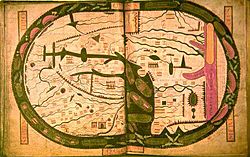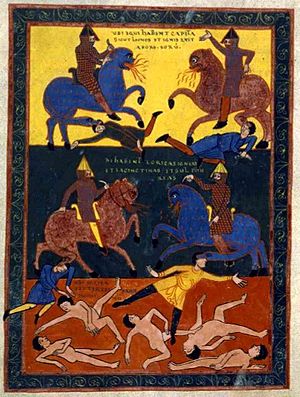Beatus of Liébana facts for kids
Quick facts for kids Saint Beatus |
|
|---|---|

The world map from the Saint-Sever Beatus measuring 37 X 57 cm. This was painted c. 1050 as an illustration to Beatus's work at the Abbey of Saint-Sever in Aquitaine, on the order of Gregori de Montaner, Abbot from 1028 to 1072.
|
|
| Born | c. 730 Duchy of Cantabria, Kingdom of Asturias |
| Died | c. 800 Liébana, Cantabria, Kingdom of Asturias |
| Venerated in | Catholic Church Eastern Orthodox Church |
| Feast | February 19 |
Saint Beatus of Liébana was a monk, a theologian (someone who studies religion), and a geographer (someone who studies maps and the Earth). He lived around the years 730 to 800. He came from a region in northern Spain called Cantabria, which was once part of the Duchy of Cantabria and the Kingdom of Asturias.
Beatus lived and worked in the Picos de Europa mountains, in a place called Liébana. He is most famous for writing a book called the Commentary on the Apocalypse. This book was a detailed explanation of the Book of Revelation from the Bible.
Contents
Who Was Beatus?
Beatus was probably born and grew up in Liébana. He might have come from a family that wasn't rich. He became an important person, serving as a spiritual advisor to Queen Adosinda. She was the wife of King Silo of Asturias. Beatus also taught famous scholars like Alcuin of York. This shows he had a lot of influence.
His Famous Book
Beatus is best known for his book, the Commentary on the Apocalypse. He first wrote it in 776. He then updated it in 784 and again in 786. This book became very popular during the Middle Ages.
Today, we have at least 34 copies of his Commentary. These copies were made between the 10th and 16th centuries. Not all of them are complete. Many of these copies are beautifully decorated with colorful pictures. These decorated books are called illuminated manuscripts. They show different art styles like Mozarabic, Romanesque, and Gothic.
A Defender of Beliefs
Beatus was a strong opponent of a religious idea called Adoptionism. This idea was put forward by two bishops, Elipandus of Toledo and Felix of Urgell. They believed that Jesus, as a human, was adopted by God. This meant they saw a big difference between Jesus's divine (godly) side and his human side.
Beatus and other religious thinkers worried that this idea would separate Jesus's two natures too much. They feared it would make people forget that Jesus was both fully human and fully divine. This debate was very important at the time.
Beatus as a Writer and Thinker
The Commentary on the Apocalypse is a very learned book. However, it wasn't full of brand-new ideas. Instead, Beatus gathered and organized information from many earlier religious writers. He included long parts from the works of important Christian leaders. These included Augustine of Hippo, Ambrose, Irenaeus, and Isidore of Seville. He also added comments on the Book of Daniel by Jerome.
Beatus's book became a symbol of Christian strength. It showed resistance against the Muslim rulers who controlled much of Spain during the early Middle Ages. This period was known as al-Andalus.
See also
 In Spanish: Beato de Liébana para niños
In Spanish: Beato de Liébana para niños
- Catholic Church in Spain


